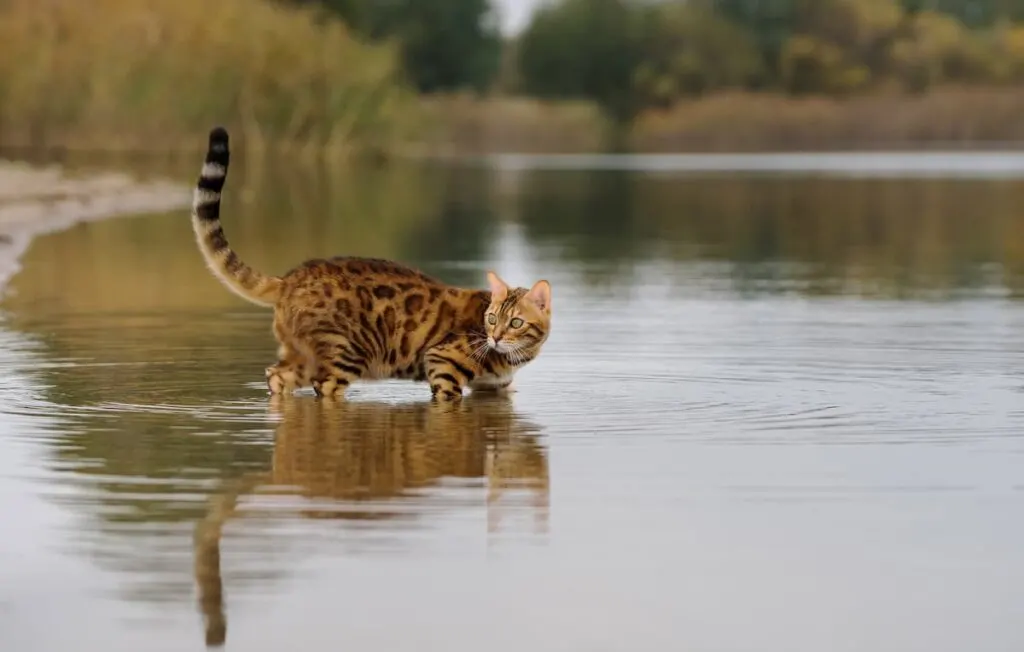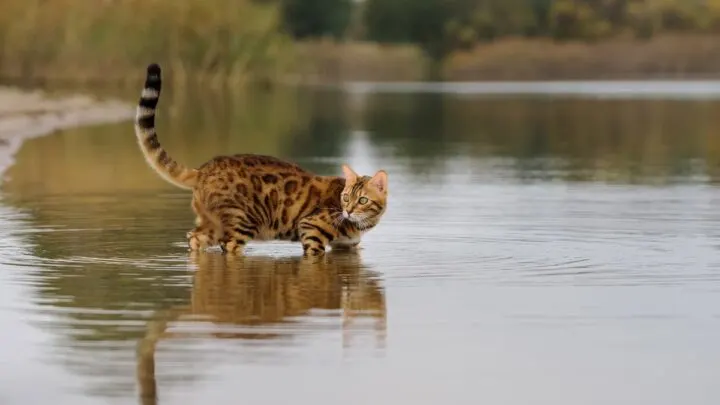Cats swimming can seem like a fun thing, but some just don’t enjoy it. However, when it comes to an energetic cat such as a Bengal, things might be a bit different. But, can Bengal cats swim?
Bengal cats can swim. All cats are born with the instincts that allow them to swim. Although most cats fear water despite these instincts, Bengal cats seem to be reasonably confident when swimming in the water.
Bengal cats are quite comfortable with water and love swimming. Of course, it is still essential to monitor your Bengal cat and follow some swimming safety tips while they are swimming.

Do Bengal Cats Hate Water
Many of us assume that Bengal cats hate water because most other domestic cats do. However, any Bengal cat owner could tell you that this can not be farther from the truth. Their fascination with water often includes them playing in their water bowl and playing with running water from the sink, in addition to swimming. Some Bengal cats may even follow their owners into the shower!
Do All Bengals Love Water
Not all Bengals will necessarily love water, but most of them do. This is partly due to their naturally curious and confident personalities and their wild Asian Leopard cat ancestors. This is because these wild cats can be found swimming in the wild, which Bengals have likely inherited.
Plus, Bengal cats usually have enough confidence to act normal even when they are swimming. As a result, some Bengal cat owners may have their Bengal cat jump into the pool with them during a pool party.
Should I Let My Cat Swim
When it comes to Bengal cats, it is usually fine if you let them swim. Many of them enjoy this activity. It is always recommended that you supervise your Bengal cat while they are swimming, though. This is to ensure your cat’s safety while they are in the water.
Even though Bengal cats are usually powerful swimmers, it is always better to be safe than sorry for pet swimming safety. We will be giving you some cat swimming safety tips a little later on in this article.
Can Cats Hold Their Breath Underwater
Like humans and other animals such as dogs, cats can hold their breath when their heads are under the water. This is an instinctual reflex in mammals. However, you should still be cautious about letting your cat put their head underwater while swimming.
This is because cats cannot hold their breath underwater for very long, so always monitoring them while swimming is a must. If you are worried about your cat’s swimming habits, then investing in a life vest or life jacket for them can help prevent them from putting their head under the water.
How Long Can A Cat Swim For
Cats can swim for a while, especially Bengal cats. However, you do not want to risk them becoming overtired, as this is where some safety concerns can come in. Try to limit your cat’s swimming to short spurts, and you should always be monitoring them while swimming.
If you have a Bengal cat that likes to swim in your pool, then it is recommended that you have pool stairs that allow for your cat to get out of the pool on its own. This way, they can get out of the pool themselves when they are feeling worn out. Plus, having pool stairs instead of just a pool ladder could potentially save your cat’s life if they decide to take a dip in the pool without you knowing about it.
Are Cats Better Swimmers Than Dogs
The answer to this question depends entirely on what breed of cat and what breed of dog that you are considering. Some dogs like pugs and French bulldogs are not good swimmers at all, and most cats are likely to be stronger swimmers than them.
However, some dogs like Labrador Retrievers are excellent swimmers, and many of them are usually better swimmers than cats. Of course, some cat breeds, such as the Bengal, are much stronger swimmers than others as well. For example, Persian cats also have pushed in faces and smaller noses, making them just as weak of swimmers as the Pug or French Bulldog.
Things To Consider
There are some other things that you should consider when it comes to Bengal cats swimming. These things include some cat swimming safety tips and knowing the signs of near-drowning in cats. Knowing these signs and following these tips can make sure that your Bengal cat’s swimming time is both fun and safe. Here are some things to consider about Bengal cats swimming.
Cat Swimming Safety Tips
You hear about dog swimming safety, but cat swimming safety is just as important. This is especially true if you have a cat that loves swimming and being around water like Bengals usually do. You must make sure that the water that your cat is about to swim in is safe, and you should always make sure that they have a way to get out of that water as well. Additionally, you should also continuously monitor your cat while they are swimming or near deep bodies of water. If you feel unsure about how strong of a swimmer your cat is, it is also recommended that you put a life vest or jacket on them before swimming.
Know The Signs of Near Drowning In Cats
Drowning is an extremely dangerous event in cats, as it can easily be life-threatening. As a result, knowing some of the signs of near-drowning could potentially save a cat’s life, especially if you have a pool or live near deep bodies of water. Some symptoms to look out for in swimming cats include but may not be limited to:
● Extreme anxiety or stress (usually seen as flailing around while swimming)
● Dilated pupils
● Water coming out of the cat’s nose or mouth
● A blue or grey tongue
● Signs of shock-like low body temperature, slow breathing rate, etc. (extremely severe, seek immediate veterinary attention)
If your cat seems to be stressed or anxious about being in the water but is showing no other signs of drowning, try and get them out as quickly as possible. It is not recommended that you get them out with your bare hands as it could cause you harm. Instead, try to grab them with a large towel or with a pool net.
Drowning often requires veterinary attention if they inhale water. As a result, you should seek veterinary attention immediately after you have found your cat drowning. This is especially true if they are showing signs of shock because this can quickly become life-threatening.

My name is James, and welcome to FAQCats!
Along with our team of cat owners, expert pet enthusiasts, and pet professionals, we aim to write engaging helpful, engaging content about cats. At FAQCats we strive to provide content that’s accurate and fun to read. Our team writes about everything related to cats; even the most complex of topics. Through extensive research and caring for our own fur-pals, we’re able to provide something cat owners worldwide will love. Have a look around, and leave us feedback anytime!

